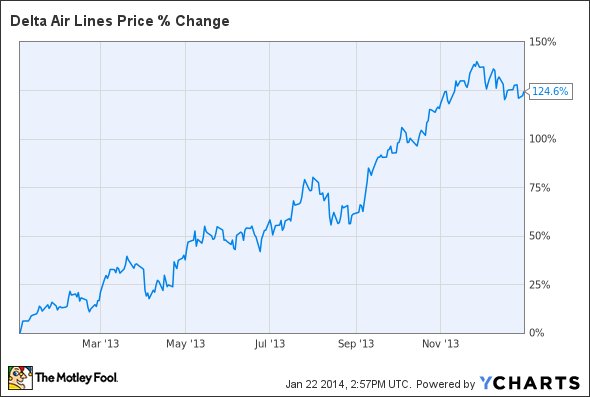
On Tuesday morning, Delta Air Lines (DAL 2.86%) reported strong Q4 earnings. Earnings per share of $0.65 came in just ahead of the analyst consensus, boosted by solid demand and a year-over-year drop in fuel prices.
All in all, Delta had a spectacular year in 2013. Net income grew by approximately $1.1 billion to $2.7 billion as unit revenue continued to grow and the company's cost containment measures started to kick in. This helped Delta stock more than double during 2013!
Delta 2013 Stock Chart, data by YCharts.
Delta expects to make further progress in 2014 through initiatives such as its new transatlantic joint venture with Virgin Atlantic and its domestic refleeting (which involves replacing 50-seat regional jets with larger, more cost-effective planes). However, by the end of this year Delta could be approaching its "ceiling." Beyond 2014, it could have trouble hitting its earnings growth target.
Momentum continues
Delta continued its revenue momentum in Q4, despite the ongoing impact of the weak yen on flights to and from Japan. Delta's domestic mainline operations were by far the strongest part of its business, delivering a 6.6% increase in unit revenue. Meanwhile, fuel prices declined year over year and non-fuel unit costs grew just 1.4% before profit sharing. These factors caused adjusted EPS to more than double year over year from $0.28 to $0.65.
For the current quarter, Delta expects an operating margin of 6%-8%, which implies roughly 300 basis points of margin expansion (similar to what Delta reported last quarter ). Once again, Delta is expecting unit revenue growth around 3% while fuel prices will decline and non-fuel cost growth will remain modest.
Hitting the targets
The biggest risk for Delta shareholders at this point is that the company could be close to peaking. At its investor day last month, management laid out a set of long-term financial targets. Delta's long-term goals include: a 10%-12% operating margin; annual EPS growth of 10%-15%; a 15% return on invested capital; and operating cash flow of more than $5 billion.
Delta's 2013 performance put it very close to hitting those targets. With its expected earnings and margin growth this year, it could end up beating its long-term goals. Excluding onetime restructuring costs, Delta's 2013 operating income totaled $3.8 billion, for an operating margin of 10% -- at the lower end of Delta's long-term-target range.
Moreover, Delta achieved a return on invested capital of 15% last year, thus hitting its long-term target. Operating cash flow was $4.8 billion, just below the long-term target of at least $5 billion.
Based on Delta's projections for strong profit growth this year, it will be nearing the high end of its operating margin target range (10%-12%). It will exceed its return on invested capital target, on a pre-tax basis, although it may fall a little short of its 15% target after factoring in a non-cash tax accrual.
Unless Delta's financial goals are overly conservative, the solid profit growth of 2013 and 2014 may not continue into 2015. Delta executives have repeatedly committed to keeping capacity growth below the rate of GDP growth, so organic growth won't be a profit driver. If 12% is really the maximum feasible operating margin, it will be hard for Delta to generate double-digit EPS growth after 2014.
The investor's dilemma
Delta has been one of the best-performing stocks in the market since late 2012. Strong demand for air travel and receding cost pressures have catalyzed strong profit growth. Investors have become optimistic about the future, too, driving up Delta's earnings multiple.
Ironically, as Delta approaches its long-term, financial goals, the stock may become less attractive. Over time, I do expect Delta to become a reliable dividend stock. However, there may be a period of adjustment later this year or next year as earnings start to plateau and investors who were betting on the company's turnaround look for greener pastures.





